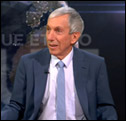For over 5,000 years, by definition, the bankers lend money they do not have but that they have previously borrowed.
To be able to borrow money to lend, trust must exist between the partners. For this, the bankers should have plenty of capital. This is necessary, unavoidable.
For millennia, the bankers could not lend much more money than they have.
At the end of the twentieth century, confidence was high in the banking system. The Fed acknowledged that banks could have liabilities of 12.5 times the amount of their equity.
This is the leverage, the multiple μ and its inverse: the Tier 1 ratio of origin to be greater than 8%.
After the financial turbulence of recent years, good old Greenspan has brought down this multiple μ (leverage) to 10.
Equity must be real: the capital provided by shareholders plus (+) accumulated profits, and nothing else.
The assets must be financed by equity and liabilities.
Under these conditions, the liabilities are all that is not equity, because the principle of double entry bookkeeping. This distinction is fundamental, irrefragable.
Americans in general understand these problems. The big US banks too big to fail now respect these principles.
The managers of big European banks will not apply these principles because they do not have enough equity and they do not want it increase because it would reduce their prices and their profitability ratios.
They therefore passed accounting rules that allow them to cheat, that is to say, getting liabilities as equity and other more complex rules.
In particular, they can acquire treasury bills in their assets without having in consideration the required equity under the pretext that they are risk-free securities, which no longer corresponds to reality, especially for the PIGS.
Big European banks respect thus accounting rules (IFRS, US GAAP) but not banking principles while big American banks and Swiss banks (private and cantonal) respect all.
Company accounts must give a true picture of reality. When accounting rules do not allow it, there is always a situation that degenerates and eventually causes a crisis.
Alan Greenspan has always discussed these issues. When he chaired the Fed, he expected the crisis to impose develop good (fair) rules that were then accepted (as it can resolve these crises).
The accounts of big European banks too big to fail do not give a true picture of reality.
There is deception on the part of their leaders since they managed to push the wrong rules … they respect
When banks like Société Générale have a real leverage of 50 announced triumphantly ratios of 28x in GAAP and a Tier 1 ratio (Basel 2) of 11.3, it is serious because their leaders knowingly deceive gullible investors who do not check whether the accounts give a true reality.
Click here to read the answer of Société Générale to my previous article.

Mr Chevallier – récemment cité outre atlantique : « Les Américains comprennent vite ce genre de problèmes ! – aurait-il oublié que 95% de ses lecteurs sont francophones ?… 🙂 Amicalement. L.
I believe that SocGen is scrambling to raise more capital in order to stabilize. In order to raise capital, they need higher prices in their shares and they need to look stable.
So, when I quoted your article, and used a title « Societe Generale is more leveraged than Lehman » they quickly reached out and sent me their own data, saying that they sent my stuff to the AMF.
Even if their calculations of 28:1 are right and your calculations of 50:1 are wrong, it is clear that they are in trouble. I hope that they will be more busy in real work to stabilize the bank, and that they will stop wasting in their time in « shooting the messengers » like myself.
No … The officers of Société Générale (and BNP Paribas), may not have a good leverage because they can not increase their equity. They deliberately mislead the French and American investors who do not understand these problems!
What do you think will happen to SocGen? Will they go bankrupt?
No! It is too big to fail! It should be recapitalized, ie nationalized, as I have written (and… DSK! former IMF president)
Très amicalement: continuez votre travail en anglais, s’il vous plait. Vous touchez à l’universalité 🙂 …. et vous touchez un large public de ce côté de l’Atlantique. De bonnes questions commencent à se poser un peu partout et dans les bons milieux. Même si tout le monde n’est pas d’accord avec votre approche.
Si vous pouviez détailler les pratiques qui consistent à intégrer des titres super-subordonnés dans les fonds propres et les risques on ferait un grand bon en avant…
J’ai trouvé ce papier http://www.xavierpaper.com/documents/art/p.Afte.01.04.05.Titres.super.subordonnes.pdf
Merci.
Stephane.
J’appuie la demande de stéphane, ca serait interessant à n’en pas douté.
Le pire dans cette histoire, c’est que la SG vient vous contredire en disant « nous avons un leverage de28 » genre 50 c’est mauvais mais 28 c’est fun, youpla on se fait des bisous partout avec ca